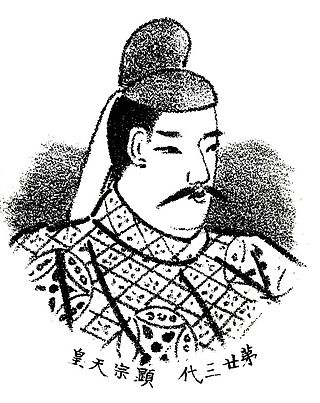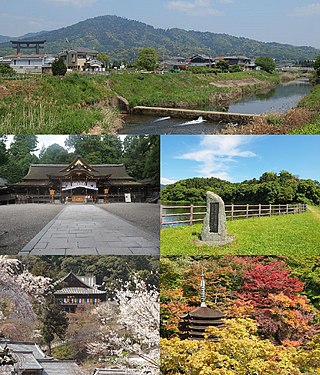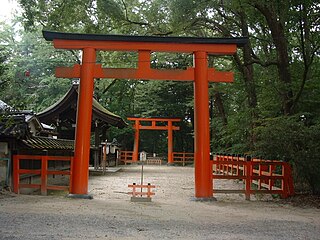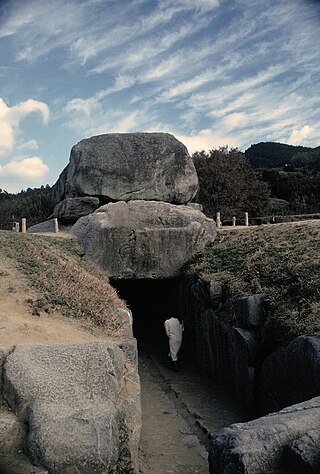List of capitals
Legendary
This list of legendary capitals of Japan begins with the reign of Emperor Jimmu. The names of the Imperial palaces are in parentheses:
- Kashihara, Yamato at the foot of Mount Unebi during reign of Emperor Jimmu [14]
- Kazuraki, Yamato during reign of Emperor Suizei [15]
- Katashiha, Kawachi during the reign of Emperor Annei [15]
- Karu, Yamato during reign of Emperor Itoku. [16]
- Waki-no-kami, Yamato during the reign of Emperor Kōshō [17]
- Muro, Yamato during reign of Emperor Kōan [17]
- Kuruda, Yamato during the reign of Emperor Kōrei [17]
- Karu, Yamato during reign of Emperor Kōgen [17]
- Izakaha, Yamato during reign of Emperor Kaika [17]
- Shika, Yamato (Palace of Mizugaki) during reign of Emperor Sujin [18]
- Shika, Yamato (Palace of Tamagaki) during reign of Emperor Suinin [19]
- Makimuko, Yamato (Palace of Hishiro) during reign of Emperor Keikō [20]
- Shiga, Ōmi (Palace of Takaanaho) during reign of Emperor Seimu [21]
- Ando, Nara (Palace of Toyoura) and Kashiki on the island of Kyushu during reign of Emperor Chūai [21]
Historical
This list of capitals includes the Imperial palaces names in parentheses.
- Karushima, Yamato (Palace of Akira), reign of Emperor Ōjin [22]
- Naniwa, Settsu (Palace of Takatsu), reign of Emperor Nintoku [23]
- Iware, Yamato (Palace of Wakasakura), reign of Emperor Richū [24]
- Tajihi, Kawachi (Palace of Shibakaki), reign of Emperor Hanzei [25]
- Asuka, Yamato (Palace of Tohotsu), reign of Emperor Ingyō [26]
- Isonokami, Yamato (Palace of Anaho), reign of Emperor Ankō [27]
- Sakurai, Nara (Hatsuse no Asakura Palace), 457–479 [28] in reign of Emperor Yūryaku [29]
- Sakurai, Nara (Iware no Mikakuri Palace), 480–484 [28] in reign of Emperor Seinei [30]
- Asuka, Yamato (Chikatsu-Asuka-Yatsuri Palace), 485–487 [31] in reign of Emperor Kenzō [30]
- Tenri, Nara (Isonokami Hirotaka Palace), 488–498 [28] in reign of Emperor Ninken [32]
- Sakurai, Nara (Nimiki Palace), 499–506 in reign of Emperor Buretsu [32]

- Hirakata, Osaka (Kuzuha Palace), 507–511[ citation needed ] [33]
- Kyōtanabe, Kyoto (Tsutsuki Palace), 511–518 in reign of Emperor Keitai [28] [34]
- Nagaoka-kyō (Otokuni Palace), 518–526 in reign of Keitai [28] [35]
- Sakurai, Nara (Iware no Tamaho Palace), 526–532 [28] in reign of Keitai [36]
- Kashihara, Nara (Magari no Kanahashi Palace), 532–535 [28] in reign of Emperor Ankan [37]
- Sakurai, Nara (Hinokuma no Iorino Palace), 535–539 [28] in reign of Emperor Senka [37]
- Asuka, Yamato (Shikishima no Kanasashi Palace), 540–571 [28] in reign of Emperor Kinmei [37]
- Kōryō, Nara (Kudara no Ohi Palace), 572–575 [ citation needed ]
- Sakurai, Nara (Osata no Sakitama Palace or Osada no Miya), 572–585 [38] in reign of Emperor Bidatsu [39]
- Shiki District, Nara (Iwareikebe no Namitsuki Palace), 585–587 [40] in the reign of Emperor Yōmei [41]
- Shiki District, Nara (Kurahashi no Shibagaki Palace), 587–592 [28] in the reign of Emperor Sushun [41]
- Asuka, Yamato (Toyura Palace or Toyura-no-miya), 593–603 [42] in the reign of Empress Suiko [43]
- Asuka, Yamato (Oharida Palace or Oharida-no-miya), 603–629 [42] in the reign of Suiko [43]
- Asuka, Yamato (Okamoto Palace or Oakmoto-no-miya), 630–636 [42] in the reign of Emperor Jomei [44]
- Kashihara, Nara (Tanaka Palace or Tanaka-no-miya), 636–639 [42]
- Kōryō, Nara (Umayasaka Palace or Umayasaka-no-miya, 640 [42]
- Kōryō, Nara (Kudara Palace or Kudara-no-miya), 640–642 [42]
- Asuka, Yamato (Oharida Palace), 642–643
- Asuka, Yamato (Itabuki Palace or Itabuki no miya), 643–645 [42] in the reign of Empress Kōgyoku [44]
- Osaka (Naniwa Nagara-Toyosaki Palace), 645–654 [45] in the reign of Emperor Kōtoku [46]
- Asuka, Yamato (Itabuki Palace), 655–655 [42] in the reign of Kōtoku [46]
- Asuka, Yamato (Kawahara Palace or Kawahara-no-miya), 655–655 [42]
- Asuka, Yamato (Okamoto Palace or Nochi no Asuka-Okamoto-no-miya), 656–660 [42] in the reign of Emperor Saimei [47]
- Asakura, Fukuoka (Asakura no Tachibana no Hironiwa Palace or Asakure no Tachibana no Hironiwa-no-miya), 660–661 [42]
- Osaka, (Naniwa Nagara-Toyosaki Palace), 661–667 [45]
- Ōtsu, Shiga (Ōmi Ōtsu Palace or Ōmi Ōtsu-no-miya), 667–672 [48] in reign of Emperor Tenji [47] and the reign of Emperor Kōbun [49]
- Asuka, Yamato (Kiyomihara Palace or Kiomihara-no-miya), 672–694 [42] in the reign of Emperor Tenmu [50] and in the reign of Empress Jitō [51]

- Fujiwara-kyō (Fujiwara Palace), 694–710 [52] in the reign of Emperor Monmu [51]

- Heijō-kyō (Heijō Palace), 710–740 [53] in the reigns of Empress Genmei, [54] Empress Genshō, [55] and Emperor Shōmu [55]
- Kuni-kyō (Kuni Palace), 740–744 [56] in the reign of Shomu [57]
- Naniwa-kyō (Naniwa Palace ), 744 [58]
- Naniwa-kyō, Shigaraki Palace, 744–745 [58]
- Heijō-kyō (Heijō Palace), 745–784 [53]
- Nagaoka-kyō (Nagaoka Palace), 784–794 [59] in the reign of Emperor Kanmu [60] [61]

- Heian-kyō (Heian Palace), 794–1180 [62] in the reign of Kammu [60] and others
- Fukuhara Palace, 1180 [63] in the reign of Emperor Antoku [64]
Medieval Japan and Early modern period (see also: History of Japan)
- Heian-kyō or Kyōto (Heian Palace), 1180–1868 [62]
- Yoshino (Nanboku-chō period), 1336–1392
Modern Japan (see also: History of Japan)
















